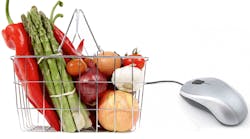While not as evident as in other industries, food and beverage is being affected by the explosion in e-commerce. In fact, the recent growth of online shopping has been described as the biggest shift in the retail food landscape and is changing faster than ever. Many of these changes are caused by new and growing customer demands. Social media and mobile applications are fueling the growth of online grocery shopping. In a 2012 Nielsen study, the number of people who indicated they intend to buy food online grew by 44 percent over the last two years. A survey by CouponCabin.com revealed more than a third of U.S. adults currently or plan to shop for groceries online. Market research firm IBISWorld says online grocery sales are estimated to grow at an annual rate of 9.5 percent to $9 billion over the next five years.
See Also: Global Supply Chain Logistics Management
Meeting the Online Fulfillment Challenge
Though today's online food market is generally regionalized, there are some major players who have the ability to grow nationally. After its establishment five years ago, AmazonFresh remains a Washington-based grocery delivery service. Amazon launched the service in 2007 and has extended service to approximately 80 ZIP codes. In 2011, its CEO Jeff Bezos told shareholders they were still "tinkering" with the business model to make it work. While the expanded Amazon distribution network could enable AmazonFresh to go national, it remains to be seen whether growth will happen anytime soon.
Peapod is one of the oldest of the online grocery services, taking root back in 1996. Its market has grown to include 13 states, including large markets in New York and Illinois. In order to build on the convenience of their offerings, Peapod placed large billboards in commuter rail stations in Chicago and Philadelphia that mimicked grocery store aisles. Using a smartphone, shoppers scan the barcode of an item to add it to their virtual grocery cart. Shoppers can either schedule a specific delivery time or schedule the order to be picked up from a Pick-Up Point (PUP). In late 2012, Peapod continued to grow this service in the northeast, from Washington to New England at over 100 commuter stations. The concept was first piloted by U.K.-based Tesco in Seoul, South Korea, and with a recently added billboard at London's Gatwick Airport.
FreshDirect was introduced to New York City in 2002 by offering custom prepared groceries and meals for its customers. The company grew to serve the greater New York area and expanded to Philadelphia last year. In 2011, U.K.-based Wm Morrison Supermarkets invested $50 million for a 10 percent stake in the company to gain and transfer knowledge to their planned Internet business in the U.K. Wal-Mart also began testing online grocery deliveries with "Walmart to Go" in the Silicon Valley in 2011. The company is now revising its online strategy, offering same-day delivery for food items and general merchandise in northern Virginia (outside DC), Philadelphia, Minneapolis and San Francisco/San Jose. Walmart has taken other e-commerce initiatives, from developing a larger fulfillment network to improving its technology platforms.
Safeway sells groceries online and offers one-hour delivery windows in select markets, although they do not consider it a significant part of their business. Harris Teeter and Piggly Wiggly provide online shopping with curbside pickup at local stores. At Stop & Shop, customers can select products in the store and shop for them online. Several new players are joining these larger retailers, such as Good Eggs based out of San Francisco. The online retailer lets consumers select items from local vendors and farmers and combines them in a single order ready for delivery or pickup. Unlike community sponsored agriculture deliveries, Good Eggs lets people customize what they want, such as specific amounts of fruit, vegetables, fish and prepared food. Good Eggs is in the process of expanding to Brooklyn and New York City, among others.
Making E-Commerce Successful
Grocery delivery or pickup is an extremely convenient service for customers, but it can be expensive for retailers. Given the razor-thin profit margins and competitive landscape, not all companies have embraced online grocery delivery. Costco Wholesale, which has a fast growing e-commerce business, does not deliver fresh foods because of the high cost. Albertsons also tried grocery home delivery but pulled the plug in 2009.
Some recent changes to senior executive roles have indicated a move toward multichannel retailing. The Delhaize Group announced the appointment of its "senior vice president of digital," a newly created role for their digital strategy for websites, social networks, customer relationship management, e-commerce, mobile and in-store.
As companies consider starting up or developing an e-commerce business, they need to consider the ramifications and changes to their supply chain. For supply chain officers to develop a successful and efficient supply chain, the company needs to define a clear business strategy. "It is always strategy before structure," according to Jim Tompkins, CEO of Tompkins International. The first step in reaching any new position of performance is to develop the right strategy for the right business. There is no substitute or shortcut. The "blind spot" where many retailers fail is by not defining their strategy well or not being able to communicate it to all stakeholders (e.g., investors, management, employees and customers).The business strategy has three components with key questions that must be answered before moving forward:
• Target Market – Who are our targeted customers? How are they segmented? What do they need and expect?
• Products, Services and Value Proposition – What do we provide, and why should our target customers buy from us? How do we distinguish our value proposition? How do we know how well we are doing?
• The Capabilities – What do we need to deliver? How should we do it and is there a compelling theme that differentiates us? What are our critical success factors?
The Guts of the Supply Chain
Once the business strategy is clear, proceed to supply chain strategy and infrastructure. Plan the network of fulfillment centers, distribution centers, direct delivery centers, forward fulfillment centers, direct special services centers, depots, forward picking locations, cross-docks and other processing/shipping locations. This network is no longer a straightforward, computer-based exercise of minimizing total costs.
A major challenge that must be met with gusto is how the network contributes to the best-in-class convenience at a profit. In addition, decisions should be made about whether to fulfill internally or outsource to logistics service providers. The fulfillment plan will include the preliminary facility plan, transportation plan, inventory deployment plan, customer interfaces and endless aisle partners.
Companies will then be required to make major process and organizational transformations, taking into account market intelligence, global players, product presentation, endless aisle, demand-driven, supply chain execution and flexibility. The new process will necessitate new enabling technology that focuses on demand shaping, non-stock inventory management, demand-driven supply chain, distributed order management, online fulfillment and inventory planning and allocations.
Advancing beyond the rising tides means retailers will need to reengineer their key performance indicators (KPIs) and approaches to compensation, along with intensifying their focus on customer-centric service and global growth. At the same time, they must address the transformational changes of the endless aisle and become more demand-driven in their supply chains.
Customer-Minded Strategy
The final step recognizes that even the best strategies, fulfillment plans, processes, organization and technologies will not be cost-effective or endear customers forever. The world of retail has changed rapidly. This will not only continue but will keep accelerating. Food retailing is all about adapting to change. Customer expectations are expanding every day, and if the company cannot keep up, the shopper will follow the path of least resistance or the path that is most convenient and pleasing. Customers have alternatives not only to products, but also where they shop and when they shop. They have other options for the ways they research, browse, compare, order, pay for, receive, unpack, use, support and/or return the products they desire.
As technology and consumer buying habits continue to change, many drivers of this transformation are in online shopping.
Consumers continue to increasingly use smart phones to compare prices online, read reviews, access coupons before they shop, and even order online to pick up products without ever stepping foot in a store. The food and beverage industry is no exception. Building an optimized omnichannel strategy, while keeping a keen eye on consumer trends, is key to ensuring success for these companies in 2013 and beyond. With online sales, social media and multichannel fulfillment, the old saying rings more true than ever before: The customer is king.
Timothy Pyne is vice president of Tompkins International (www.tompkinsinc.com).





